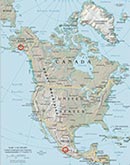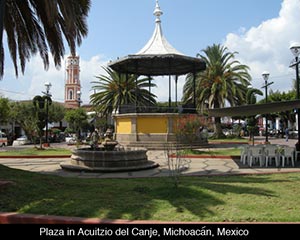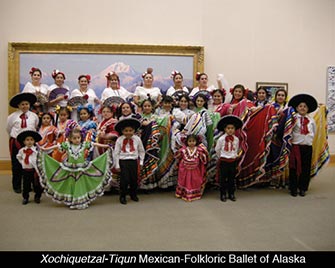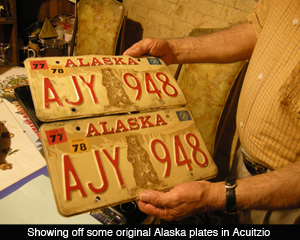ISER visiting research scholar presents preliminary Alaska-Michoacan connections
by Kathleen McCoy |
 Connections between Anchorage and Mexico? For many Alaskans that brings to mind the
Alaska Airlines terminal at the Seattle-Tacoma airport in March, suitcases full of
swimwear, flip-flops and guidebooks. But beyond a sunny vacation destination for vitamin
D-starved northerners, Mexico is one part of a complex "home" identity for a sampling
of Anchorage residents. Sara Komarnisky, Ph.D. candidate from the University of British
Columbia, Vancouver's Department of Anthropology, has been identifying and exploring
the ties between Anchorage and Acuitzio del Canje, a town in the central Mexican state
of Michoacán, for the past eight years. And for the past nine months, while completing
her field research in Anchorage, she has been an international visiting research scholar
with UAA's Institute of Social and Economic Research (ISER).
Connections between Anchorage and Mexico? For many Alaskans that brings to mind the
Alaska Airlines terminal at the Seattle-Tacoma airport in March, suitcases full of
swimwear, flip-flops and guidebooks. But beyond a sunny vacation destination for vitamin
D-starved northerners, Mexico is one part of a complex "home" identity for a sampling
of Anchorage residents. Sara Komarnisky, Ph.D. candidate from the University of British
Columbia, Vancouver's Department of Anthropology, has been identifying and exploring
the ties between Anchorage and Acuitzio del Canje, a town in the central Mexican state
of Michoacán, for the past eight years. And for the past nine months, while completing
her field research in Anchorage, she has been an international visiting research scholar
with UAA's Institute of Social and Economic Research (ISER).
In a recent ISER Lunchtime Talk, UAA Professor Emeritus Kerry Feldman, president of the Alaska Anthropology Association, introduced Komarnisky, whose master's research had captured his attention in 2005 when she first came to Anchorage. This project resulted in an article, "Suitcases Full of Mole: Traveling Food and the Connections Between Mexico and Alaska," that was selected for publication in the Alaska Journal of Anthropology. Feldman emphasized the need for modern anthropological study focused on growing, changing urban Alaska and praised Komarnisky's work for doing just that.

Komarnisky's ethnographic research follows a sampling of people in Anchorage and in Acuitzio del Canje to determine how they create and live in what she terms a "transnational space." She presented some of her early research findings, discussed how her project began and simplified some anthropology terminology for the diverse audience in attendance at the ISER-sponsored event.
Ethnographers immerse themselves in the social world of the people they are studying, and Komarnisky's final research outcomes, detailing the movements, interactions and perceptions of the three generations (dating back to 1953 in Alaska) who consider both Anchorage and Acuitzio del Canje home, will be based on years of observations in both Alaska and Michoacán, dozens of interviews and some archival research.
"What? There are Mexicans in Alaska?" reads one of the first slides in Komarnisky's PowerPoint presentation. Komarnisky was struck by how often people greeted this population fact with surprise when she presented the results of her master's research tracing the interchange of foods and food culture between Acuitzio and Anchorage, and it motivated her to broaden her study. Why that disconnect?
What interests Komarnisky is the "production of space." It's a concept first touted by French sociologist Henri Lefebvre, who says that social space is a product, it is something that we make. For instance, think about how Alaska and Mexico are produced as separate and different from each other. Part of that is their strong association with certain ideas and images--Alaska is perceived to be distant (from the rest of the U.S.), pioneering, cold, full of oil and bears, while Mexico is thought of as beaches and desert, poor, full of tourists and drug cartels. And those are the short lists, but you get the idea. Everyone can conjure up a complex version of Alaska or Mexico. And side-by-side, they are more readily described in terms of differences than similarities.
However, these two geographies are very much connected through the movements of people. "People who travel can produce new spaces," says Komarnisky, and in this case, people can be said to be living in a social space that spans the distance between Anchorage and their hometown in Michoacán. Over the generations, through daily life and movements, people produce a social space that connects Acuitzio del Canje and Anchorage. How do they do this?
Well for one thing, there has been regular travel between Anchorage and Acuitzio since at least 1953, when the first migrants from Acuitzio came to Alaska to look for work. These first migrants were looking for higher pay, but they were also adventurous individuals. Travel between these two places continues today. When people travel, they bring things and ideas with them, and that also produces a connection between these locations. People work to build and maintain social networks in both Anchorage and Acuitzio, and they also actively seek out skills and statuses that help them to exist here or there. This might mean applying for U.S. citizenship to make border crossing easy, or it might mean encouraging children to speak Spanish so that they can communicate with family and friends in their hometown.

There are broad implications of Komarnisky's ethnographic research. As Dr. Feldman mentioned in his introduction, Alaska has a dynamic urban population and there isn't enough research concerned with the relatively new arrivals of the 20th and 21st centuries. U.S. census data tells us Alaska is home to 38,000+ people who self-identify as Hispanic in origin, with more than half of them selecting Mexican as their ethnic background. She notes that by documenting the lives of the people who call both Anchorage and Acuitzio del Canje home and have for several generations, we may be forced to rethink Alaska history. For instance, there are, she says, Acuitzences who remember the '64 quake, the building of the pipeline, the rise of the commercial fishing industry and other fabled "sourdough" stories. A comprehensive ethnography can contest stereotypes and contribute to a full picture of cities and immigration in the modern circumpolar north.

Komarnisky's research into the things that travel, the people who travel and the ideas and traditions that travel with them and develop over time in Acuitzio del Canje and Anchorage will be completed in 2014, when she plans to accept her doctoral degree in anthropology.
 "ISER visiting research scholar presents preliminary Alaska-Michoacan connections " is licensed under a Creative Commons Attribution-NonCommercial 4.0 International License.
"ISER visiting research scholar presents preliminary Alaska-Michoacan connections " is licensed under a Creative Commons Attribution-NonCommercial 4.0 International License.









